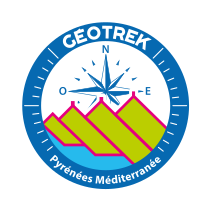Bike ride around Argeles-sur-Mer (mountain bike)

ARGELES SUR MER
Bike ride around Argeles-sur-Mer (mountain bike)
Easy
1h30
12,7km
+90m
-91m
Embed this item to access it offline
Discover the village passing by little streets and pathes to end on a hight note on the ports and the sandy beaches of Argelès-sur-Mer
5 points of interest
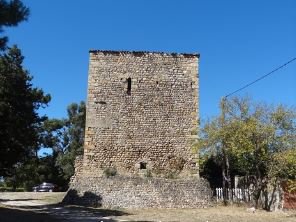
Tour de Pujol - les-pyrenees-orientales.com  History
HistoryCastle of Pujols
This castle, more commonly known as the "Tower of Pujol," appears to have been built during the 11th century under the initiative of the Count of Roussillon.
Upon the creation of the Viscounty of Tatzo (Taxo), the count entrusted this stronghold to the new viscount. However, in 1143, a local war erupted between Count Gaufred and Viscount Bérenger of Llupia over Pujol itself. Better armed, the count was able to reclaim it militarily. A final agreement was reached on October 26, 1143, between the two parties.
It seems that Pujol subsequently remained a possession of the Count of Roussillon, whose entire estate passed to the Count of Barcelona upon the death of Guinard II, and later to the King of Mallorca with the creation of this short-lived kingdom. The castle reappears in history in 1343, when the King of Aragon, a sworn enemy (and cousin) of the King of Mallorca, attempted to invade Roussillon by force. His troops crossed the Pyrenees, captured Banyuls and Collioure in succession, and laid siege to the castle of Pujol. It was June 2, 1343. The assault was launched, but Pujol defended itself well. Repelled, the attackers withdrew.
The following day, they attacked the town of Argelès, but once again, the inhabitants, aided by a group of Genoese mercenaries, managed to drive them back. However, they eventually succeeded in capturing Pujol some time later, with the Kingdom of Mallorca ultimately falling into the hands of the King of Aragon.
(Source: les-pyrenees-orientales.com)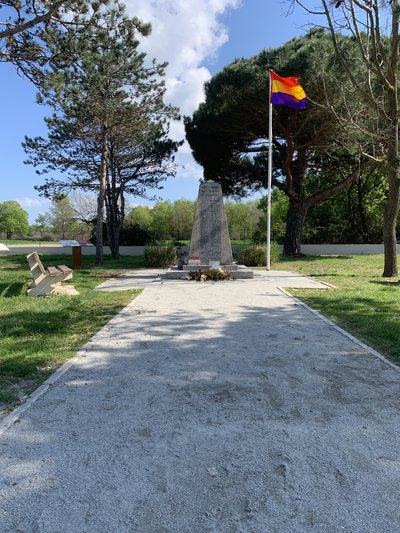
Cimetières des Espagnols - Mémorial du camp d’Argelès  History
HistorySpanish Cemetery
Nearly 400 internees died in the Argelès-sur-Mer camp or following transfers to hospitals in Perpignan between 1939 and 1942. A quarter of them were children. All were refugees, mostly Spanish, but also French Roma and refugees from nearly 50 nationalities interned on Argelès-sur-Mer beach, one of the largest camps in southern France.
The camp cemetery was devastated by floods in October 1940. In 1953, after the commune acquired a part of the former cemetery grounds, a Belgian citizen donated a memorial stele engraved with the names of some of the men, women, and children who died in the camp. This site, maintained for many years by former internees, has become a place of memory and reflection, and it remains the last vestige of the camp.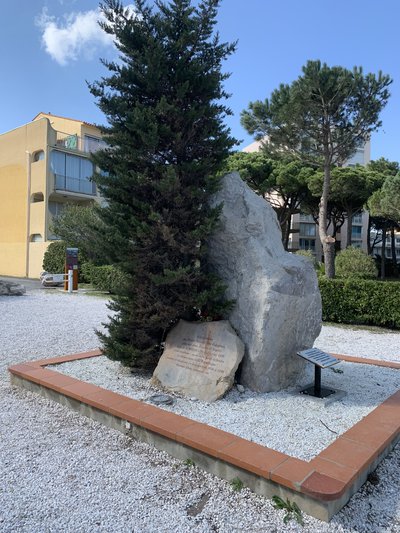
Mémorial du camp d’Argelès  History
HistoryThe Camp Monolith
The monolith at the camp marks the southern entrance to the Argelès-sur-Mer camp, which was opened in early February 1939 to intern some of the refugees who had fled Spain during "La Retirada." Over 100,000 refugees, including women and children, passed through the camp until summer 1939, all sleeping directly on the sand in makeshift shelters. The camp was reorganized and reopened following the declaration of war in September 1939. After France's defeat in June 1940, the camp became more international, with refugees from Northern and Eastern Europe, including foreign Jews, and the return of Spanish workers. The Vichy government used it as one of the main camps in southern France, interning French nomads there in the autumn of 1940.
People from over fifty nationalities lived together behind the barbed wire at Argelès. These "undesirables" were confined on a beach where living conditions were extremely harsh, with high mortality rates, particularly among infants. In 1941, the Ministry of the Interior transferred most of the internees to the Rivesaltes camp and deported some Spaniards and international brigadiers to camps in Algeria. By June 1942, with only a hospital remaining, the Argelès-sur-Mer camp was converted into a French Youth Work Camp before closing permanently in November. Erected in 1999, this monolith pays tribute to all the refugees who passed through the camp.

Stephane Ferrer 
Port Footbridge
A true link between the Port and the Beach, the Massane Footbridge is crossed by more than 200,000 visitors each summer.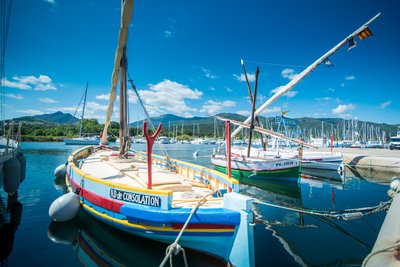
Stephane Ferrer  History
HistoryCatalan Boat
Catalan boats were used for net fishing of sardines and anchovies along the Catalan and Spanish coasts. In Collioure in 1900, there were 120 Catalan boats dedicated to sardine ("sardinal") and anchovy ("anxove") fishing. You can still find them along the coastline, lovingly restored by enthusiasts.
Description
- To reach the village from the Valmy carpark take the direction of the campsite "Les Mimosas" then turn on the left again and take the road of la Massane.
- 2. Ride along the fast road and continue straight towards Auberge du Roua.
- A t the Auberge du Roua, continue straight on and pass under the bridge. At the ford , go up the bank and pass through the small path of the Valmy carpark mall path on your left the Rue des Micocouliers.
- Arriving in front of the wine-growers cooperative , bypass it to join the river La Massana.After the ford, take the first “bridge” on the left. This path joins up with another path, which does not allow cars, so it is extra safe for children..
- Continue straight on, pass in front of the city hall of Argeles -sur-Mer and cross or bypass the carpark to reach le "Cami de la Mainada".
- At the roundabout, take the dirt road alongside the gardens, and opening in front of Espace Jean Carrère Take a left and cross the road in direction of le Chemin des Conques.
- After the city park, take the path on the right. Follow the dirt path that enters into the fields. The campsite Beauséjour is situated at the end of the path.
- At the junction with the Avenue du Tech, continue straight on and take the avenue des Albères. Take the cycle path on the right to reach the tourist office.
- To extend the bike ride that normally ends on the beach, take the third exit on the roundabout. along the seaside walking path in a southerly direction until the exhibition of large picture realised by Les Enfants de la Mer.
- Departure : Valmy carpark (base mountain bike)
- Arrival : Valmy carpark (base mountain bike)
- Towns crossed : ARGELES SUR MER
Altimetric profile
Recommandations
Follow the signs (Moutain VTT) green color n°1
